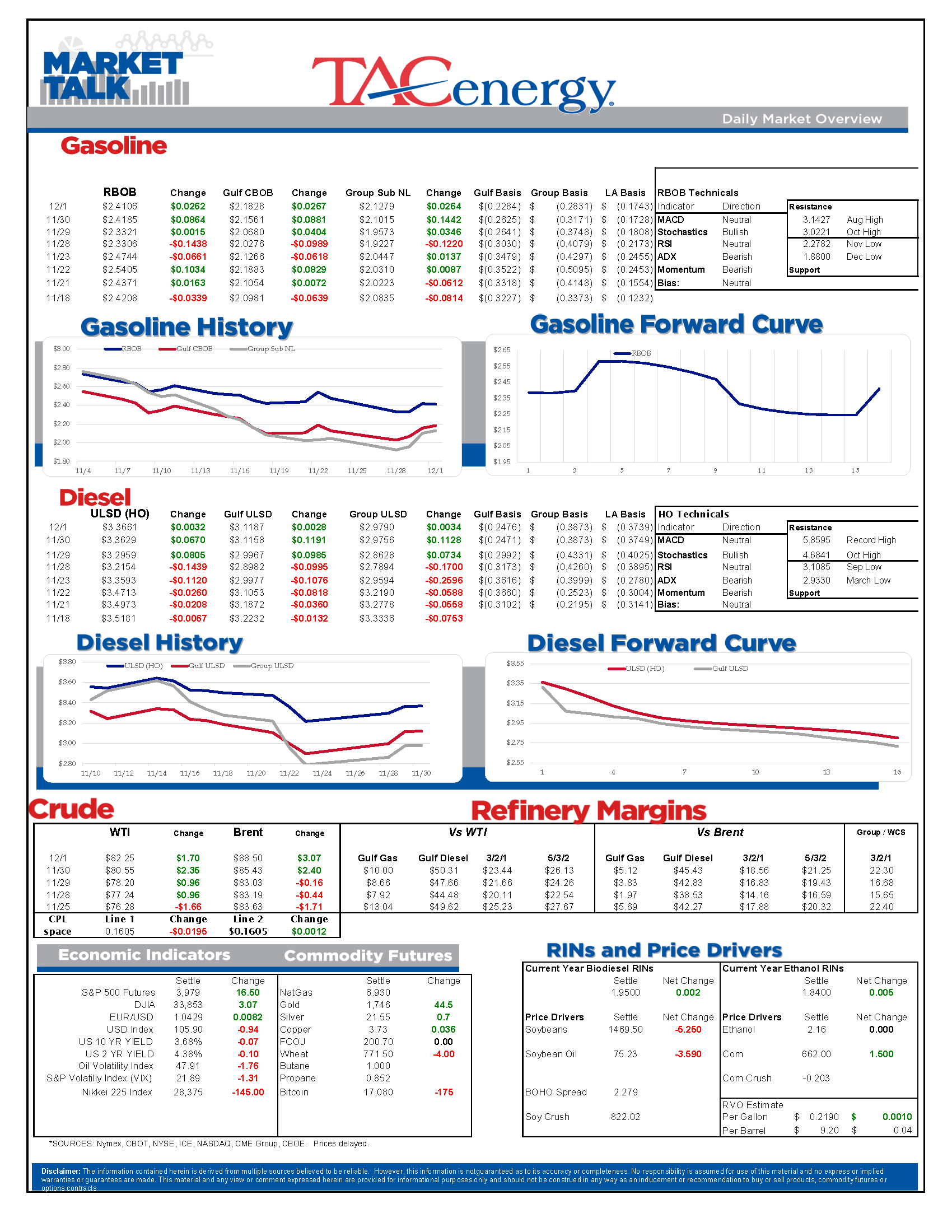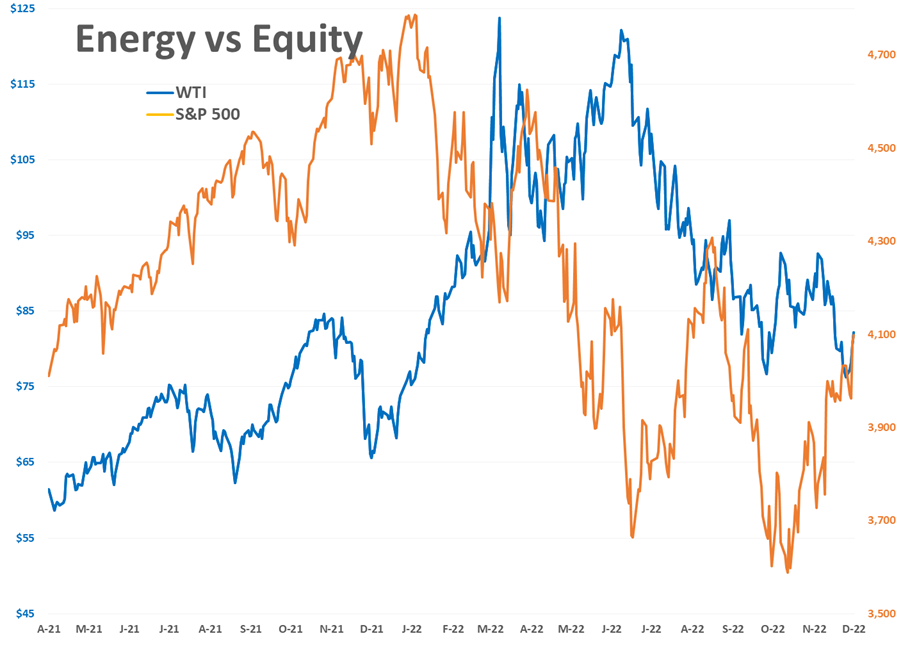December Trading Is Kicking Off With Modest Gains For Energy Contracts

December trading is kicking off with modest gains for energy contracts after a strong finish to November helped the complex avoid a technical breakdown.
Equity markets saw another big rally Wednesday after the FED chair suggested that smaller rate hikes were coming. The correlation between energy and equity markets remains weak, so it doesn’t seem like that’s having much influence on daily pricing, but it certainly doesn’t hurt the case for a recovery rally. New reports that China may ease some lockdowns in the wake of last weekend’s protests is also getting some credit for the strength in prices after they reached 11 month lows on Monday.
The DOE’s weekly report had something for everyone with crude oil stocks showing some bullish figures while refined product supplies got some much-needed relief.
US Crude oil inventories saw a huge drop of more than 12 million barrels last week thanks to a surge in exports to the 3rd highest level on record, a drop in imports, and the SPR sales that have been supplementing commercial supplies for the past 6 months wind down. The market reaction was fairly muted to the big headline drop, which is probably due to the inconsistent nature of the import/export flows, which are likely to reverse course next week. The lack of SPR injections will be a key figure to watch through the winter, particularly as the Russian embargo starts next week.
Diesel inventories increases across all 5 PADDs last week, as demand dipped again and imports ticked higher. Diesel exports remain above average, and are expected to continue that pace in the near term as European and Latin American buyers continue to be short. Read this note for why in the long term more of those supplies will probably come from China or Kuwait.
US refiners continue to run all-out, with total throughput last week reaching its highest level since the start of the pandemic, even though we’ve lost more than 600,000 barrels/day of capacity since then. Those high run rates at a time of soft demand help explain why we’re seeing big negative basis values at the refining hubs around the country and if the pipeline and vessel outlets can’t keep pace to move that product elsewhere we may see those refiners forced to cut back due to lack of storage options.
The EPA was required by court order to submit its plans for the renewable fuel standard by November 16, and then came to an agreement to release them on November 30, and then apparently decided to meet that deadline, but not release the plan to the public. If you think this is ridiculous, you’re not alone, but keep in mind this is the same agency that regularly missed the statutory deadline by more than a year previously, so it’s also not too surprising. This is also the law that required 16 billion gallons/year of cellulosic biofuels be blended by 2022 when it was put into place 15 years ago, only to run into a wall of physical reality where the country is still unable to produce even 1 billion gallons/year of that fuel.
There are still expectations that the public may get to see the proposed rulings later this week, and reports that renewable electricity generation will be added to the mix for the first time ever starting next year. RIN prices were pulling back from the 18 month highs they reached leading up to the non-announcement as it seems the addition of “eRINs” will add new RIN supply, and potentially offset the increased biofuel mandates.
Latest Posts
Gasoline Futures Are Leading The Way Lower This Morning
The Sell-Off Continues In Energy Markets, RBOB Gasoline Futures Are Now Down Nearly 13 Cents In The Past Two Days
Week 15 - US DOE Inventory Recap
Prices To Lease Space On Colonial’s Main Gasoline Line Continue To Rally This Week
Social Media
News & Views
View All
Gasoline Futures Are Leading The Way Lower This Morning
It was a volatile night for markets around the world as Israel reportedly launched a direct strike against Iran. Many global markets, from equities to currencies to commodities saw big swings as traders initially braced for the worst, then reversed course rapidly once Iran indicated that it was not planning to retaliate. Refined products spiked following the initial reports, with ULSD futures up 11 cents and RBOB up 7 at their highest, only to reverse to losses this morning. Equities saw similar moves in reverse overnight as a flight to safety trade soon gave way to a sigh of relief recovery.
Gasoline futures are leading the way lower this morning, adding to the argument that we may have seen the spring peak in prices a week ago, unless some actual disruption pops up in the coming weeks. The longer term up-trend is still intact and sets a near-term target to the downside roughly 9 cents below current values. ULSD meanwhile is just a nickel away from setting new lows for the year, which would open up a technical trap door for prices to slide another 30 cents as we move towards summer.
A Reuters report this morning suggests that the EPA is ready to announce another temporary waiver of smog-prevention rules that will allow E15 sales this summer as political winds continue to prove stronger than any legitimate environmental agenda. RIN prices had stabilized around 45 cents/RIN for D4 and D6 credits this week and are already trading a penny lower following this report.
Delek’s Big Spring refinery reported maintenance on an FCC unit that would require 3 days of work. That facility, along with several others across TX, have had numerous issues ever since the deep freeze events in 2021 and 2024 did widespread damage. Meanwhile, overnight storms across the Midwest caused at least one terminal to be knocked offline in the St. Louis area, but so far no refinery upsets have been reported.
Meanwhile, in Russia: Refiners are apparently installing anti-drone nets to protect their facilities since apparently their sling shots stopped working.
Click here to download a PDF of today's TACenergy Market Talk.

The Sell-Off Continues In Energy Markets, RBOB Gasoline Futures Are Now Down Nearly 13 Cents In The Past Two Days
The sell-off continues in energy markets. RBOB gasoline futures are now down nearly 13 cents in the past two days, and have fallen 16 cents from a week ago, leading to questions about whether or not we’ve seen the seasonal peak in gasoline prices. ULSD futures are also coming under heavy selling pressure, dropping 15 cents so far this week and are trading at their lowest level since January 3rd.
The drop on the weekly chart certainly takes away the upside momentum for gasoline that still favored a run at the $3 mark just a few days ago, but the longer term up-trend that helped propel a 90-cent increase since mid-December is still intact as long as prices stay above the $2.60 mark for the next week. If diesel prices break below $2.50 there’s a strong possibility that we see another 30 cent price drop in the next couple of weeks.
An unwind of long positions after Iran’s attack on Israel was swatted out of the sky without further escalation (so far anyway) and reports that Russia is resuming refinery runs, both seeming to be contributing factors to the sharp pullback in prices.
Along with the uncertainty about where the next attacks may or may not occur, and if they will have any meaningful impact on supply, come no shortage of rumors about potential SPR releases or how OPEC might respond to the crisis. The only thing that’s certain at this point, is that there’s much more spare capacity for both oil production and refining now than there was 2 years ago, which seems to be helping keep a lid on prices despite so much tension.
In addition, for those that remember the chaos in oil markets 50 years ago sparked by similar events in and around Israel, read this note from the NY Times on why things are different this time around.
The DOE’s weekly status report was largely ignored in the midst of the big sell-off Wednesday, with few noteworthy items in the report.
Diesel demand did see a strong recovery from last week’s throwaway figure that proves the vulnerability of the weekly estimates, particularly the week after a holiday, but that did nothing to slow the sell-off in ULSD futures.
Perhaps the biggest next of the week was that the agency made its seasonal changes to nameplate refining capacity as facilities emerged from their spring maintenance.
PADD 2 saw an increase of 36mb/day, and PADD 3 increased by 72mb/day, both of which set new records for regional capacity. PADD 5 meanwhile continued its slow-motion decline, losing another 30mb/day of capacity as California’s war of attrition against the industry continues. It’s worth noting that given the glacial pace of EIA reporting on the topic, we’re unlikely to see the impact of Rodeo’s conversion in the official numbers until next year.
Speaking of which, if you believe the PADD 5 diesel chart below that suggests the region is running out of the fuel, when in fact there’s an excess in most local markets, you haven’t been paying attention. Gasoline inventories on the West Coast however do appear consistent with reality as less refining output and a lack of resupply options both continue to create headaches for suppliers.





